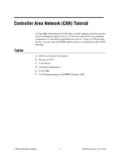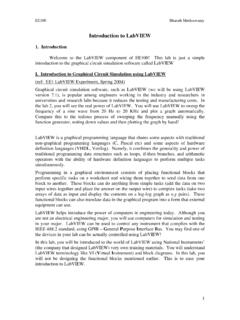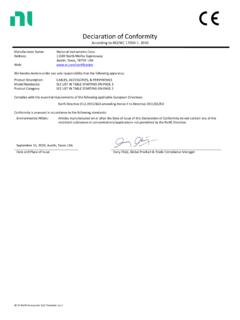Transcription of Understanding FFTs and Windowing - National Instruments
1 FFTs and Windowing OverviewLearn about the time and frequency domain, fast Fourier transforms (FFTs), and Windowing as well as how you can use them to improve your Understanding of a signal. This tutorial is part of the Instrument Fundamentals series. ContentswwUnderstanding the Time Domain, Frequency Domain, and FFTa. All Signals Are the Sum of Sinesb. Deconstructing Signals Using the FFTwwWindowinga. What Is Windowingb. Windowing FunctionswwSummaryUnderstanding FFTs and the Time Domain, Frequency Domain, and FFTThe Fourier transform can be powerful in Understanding everyday signals and troubleshooting errors in signals. Although the Fourier transform is a complicated mathematical function, it isn t a complicated concept to understand and relate to your measured signals. Essentially, it takes a signal and breaks it down into sine waves of different amplitudes and frequencies. Let s take a deeper look at what this means and why it is useful.
2 A. All Signals Are the Sum of SinesWhen looking at real-world signals, you usually view them as a voltage changing over time. This is referred to as the time domain. Fourier s theorem states that any waveform in the time domain can be represented by the weighted sum of sines and cosines. For example, take two sine waves, where one is three times as fast as the other or the frequency is 1/3 the first signal. When you add them, you can see you get a different imagine if that second wave was also 1/3 the amplitude. This time, just the peaks are 1. When you add two signals, you get a new signal. BackNextUnderstanding FFTs and you added a third signal that was 1/5 the amplitude and frequency of the original signal. If you continued in this fashion until you hit the noise floor, you might recognize the resulting 2. Adjusting the amplitude when adding signals affects the 3. A square wave is the sum of FFTs and have now created a square wave.
3 In this way, all signals in the time domain can be represented by a series of sines. Although it is pretty neat that you can construct signals in this fashion, why do you actually care? Because if you can construct a signal using sines, you can also deconstruct signals into sines. Once a signal is deconstructed, you can then see and analyze the different frequencies that are present in the original signal. Take a look at a few examples where being able to deconstruct a signal has proven useful: If you deconstruct radio waves, you can choose which particular frequency or station you want to listen to. If you deconstruct audio waves into different frequencies such as bass and treble, you can alter the tones or frequencies to boost certain sounds to remove unwanted noise. If you deconstruct earthquake vibrations of varying speeds and strengths, you can optimize building designs to avoid the strongest vibrations. If you deconstruct computer data, you can ignore the least important frequencies and lead to more compact representations in memory, otherwise known as file Deconstructing Signals Using the FFTThe Fourier transform deconstructs a time domain representation of a signal into the frequency domain representation.
4 The frequency domain shows the voltages present at varying frequencies. It is a different way to look at the same signal. A digitizer samples a waveform and transforms it into discrete values. Because of this transformation, the Fourier transform will not work on this data. Instead, the discrete Fourier transform (DFT) is used, which produces as its result the frequency domain components in discrete values, or bins. The fast Fourier (FFT) is an optimized implementation of a DFT that takes less computation to perform but essentially just deconstructs a a look at the signal from Figure 1 above. There are two signals at two different frequencies; in this case, the signal has two spikes in the frequency domain one at each of the two frequencies of the sines that composed the signal in the first FFTs and amplitude of the original signal is represented on the vertical axis. If you look at the signal from Figure 2 above where there are two different signals at different amplitudes, you can see that the most prominent spike corresponds to the frequency of the highest voltage sine signal.
5 Looking at a signal in the time domain, you can get a good idea of the original signal by knowing at what frequencies the largest voltage signals 4. When two sine waves of equal amplitude are added, they result in two spikes in the frequency 5. The highest spike is the frequency of the largest FFTs and can also be helpful to look at the shape of the signal in the frequency domain. For instance, let s take a look at the square wave in the frequency domain. We created the square wave using many sine waves at varying frequencies; as such, you would expect many spikes in the signal in the frequency domain one for each signal added. If you see a nice ramp in the frequency domain, you know the original signal was a square what does this look like in the real world? Many mixed-signal oscilloscopes (MSO) have an FFT function. Below, you can see what an FFT of a square wave looks like on a mixed-signal graph. If you zoom in, you can actually see the individual spikes in the frequency 6.
6 The frequency domain of a sine wave looks like a 7. The original sine wave and its corresponding FFT are displayed in A, while B is a zoomed in portion of the FFT where you can see the individual FFTs and at signals in the frequency domain can help when validating and troubleshooting signals. For instance, say you have a circuit that is supposed to output a sine wave. You can view the output signal on the oscilloscope in the time domain in Figure 8 below. It looks pretty good!However, when you view the signal in the frequency domain, you expect only one spike because you are expecting to output a single sine wave at only one frequency. However, you can see that there is a smaller spike at a higher frequency; this is telling you that the sine wave isn t as good as you thought. You can work with the circuit to eliminate the cause of the noise added at that particular frequency. The frequency domain is great at showing if a clean signal in the time domain actually contains cross talk, noise, or 8.
7 If these two waves were added, they would look like a perfect sine wave because they are so 9. Looking at the seemingly perfect sine wave from Figure 8, you can see here that there is actually a FFTs and performing an FFT on a signal can provide great insight, it is important to know the limitations of the FFT and how to improve the signal clarity using What Is WindowingWhen you use the FFT to measure the frequency component of a signal, you are basing the analysis on a finite set of data. The actual FFT transform assumes that it is a finite data set, a continuous spectrum that is one period of a periodic signal. For the FFT, both the time domain and the frequency domain are circular topologies, so the two endpoints of the time waveform are interpreted as though they were connected together. When the measured signal is periodic and an integer number of periods fill the acquisition time interval, the FFT turns out fine as it matches this 10.
8 measuring an integer number of periods (A) gives an ideal FFT (B).ABUnderstanding FFTs and , many times, the measured signal isn t an integer number of periods. Therefore, the finiteness of the measured signal may result in a truncated waveform with different characteristics from the original continuous-time signal, and the finiteness can introduce sharp transition changes into the measured signal. The sharp transitions are the number of periods in the acquisition is not an integer, the endpoints are discontinuous. These artificial discontinuities show up in the FFT as high-frequency components not present in the original signal. These frequencies can be much higher than the Nyquist frequency and are aliased between 0 and half of your sampling rate. The spectrum you get by using a FFT, therefore, is not the actual spectrum of the original signal, but a smeared version. It appears as if energy at one frequency leaks into other frequencies.
9 This phenomenon is known as spectral leakage, which causes the fine spectral lines to spread into wider 11. measuring a noninteger number of periods (A) adds spectral leakage to the FFT (B).ABUnderstanding FFTs and can minimize the effects of performing an FFT over a noninteger number of cycles by using a technique called Windowing . Windowing reduces the amplitude of the discontinuities at the boundaries of each finite sequence acquired by the digitizer. Windowing consists of multiplying the time record by a finite-length window with an amplitude that varies smoothly and gradually toward zero at the edges. This makes the endpoints of the waveform meet and, therefore, results in a continuous waveform without sharp transitions. This technique is also referred to as applying a Windowing FunctionsThere are several different types of window functions that you can apply depending on the signal. To understand how a given window affects the frequency spectrum, you need to understand more about the frequency characteristics of windows.
10 An actual plot of a window shows that the frequency characteristic of a window is a continuous spectrum with a main lobe and several side lobes. The main lobe is centered at each frequency component of the time-domain signal, and the side lobes approach zero. The height of the side lobes indicates the affect the Windowing function has on frequencies around main lobes. The side BackNextFigure 12. Applying a window minimizes the effect of spectral FFTs and response of a strong sinusoidal signal can overpower the main lobe response of a nearby weak sinusoidal signal. Typically, lower side lobes reduce leakage in the measured FFT but increase the bandwidth of the major lobe. The side lobe roll-off rate is the asymptotic decay rate of the side lobe peaks. By increasing the side lobe roll-off rate, you can reduce spectral a window function is not a simple task. Each window function has its own characteristics and suitability for different applications.









